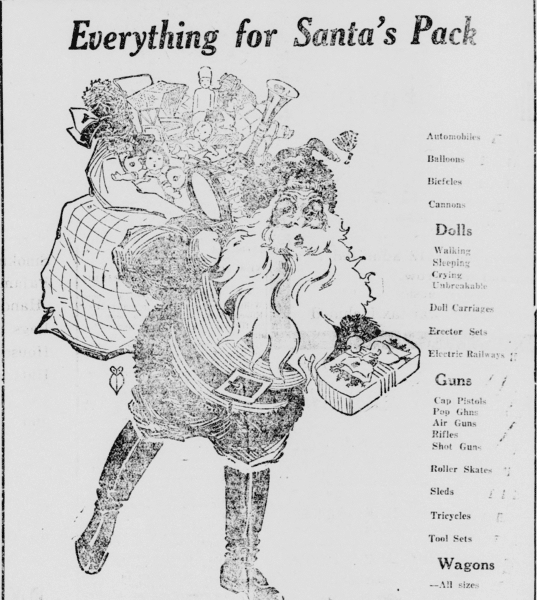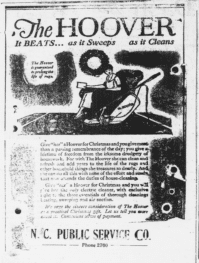NEWS
The Holiday Season a Century Ago

During the early 1920s, America was recovering from hard times. World War I had just ended, as had the Spanish flu epidemic. The economy seemed to be coming back, fashions were changing, and there were many new daily conveniences. While holiday traditions remained largely the same, new ones were appearing.
Of course, the Christmas season was dominated by religious activities: nativity plays, Christmas Eve services, Christmas morning services, and traditional programs at churches and schools. Homes were decorated with wreaths and garlands, lights and candles. There were nativity scenes, train sets, and Christmas villages. And of course, the stockings were hung by the chimney. Homes were usually not decorated until Christmas week, or even Christmas Eve. Christmas trees, decorated with popcorn strings, homemade paper chains, pine cones, paper snowflakes, tinsel, and occasionally electric lights, were often put up on Christmas Eve. Often pines and cedars cut from the woods, were put up on during Christmas week and were taken down around New Year’s – the candles that decorated them kept people from keeping them up longer. This tradition (minus the candles) continued in my family as late as the 1960s.
Christmas stockings often contained simple things, such as fruit, nuts, candy, and perhaps a small toy. The stockings themselves were not decorative but were the family’s ordinary knee-length socks. Many people exchanged handmade Christmas gifts like gloves, mittens, and scarves. These might be joined by Raggedy Ann dolls or metal toys. Roller skates, wagons, bicycles, and train sets sometimes supplemented these humbler offerings. Yo-yos, tinker toys, and electric trains were some of the newer offerings. In 1920, Abernethy’s in Hickory was offering electric toys. An advertisement from Hickory details the wide range of items available for children.
 In 1925, Atwater Kent in Elizabeth City was advertising radios for $80 and up, so that customers could “Keep the Folks Home” with “the world’s best music, speeches, lectures and entertainment.” On December 15, 1921, the High Point Review included an advertisement for one of the hot new gifts for women: a vacuum cleaner. Other popular appliances were electric irons and toasters. Like today, on Christmas morning most families gathered for a gift exchange, followed by a big Christmas meal. The menu usually featured a roast goose, chicken, turkey, or even duck. Cakes, pies, and cookies were included. And since the introduction of Jell-O in 1897, there were even colorful gelatin molds.
In 1925, Atwater Kent in Elizabeth City was advertising radios for $80 and up, so that customers could “Keep the Folks Home” with “the world’s best music, speeches, lectures and entertainment.” On December 15, 1921, the High Point Review included an advertisement for one of the hot new gifts for women: a vacuum cleaner. Other popular appliances were electric irons and toasters. Like today, on Christmas morning most families gathered for a gift exchange, followed by a big Christmas meal. The menu usually featured a roast goose, chicken, turkey, or even duck. Cakes, pies, and cookies were included. And since the introduction of Jell-O in 1897, there were even colorful gelatin molds.
New Year’s Eve traditions may also seem familiar. Many individuals and businesses hosted New Year’s Eve parties. In cities, these were lavish events attended by hundreds of people and included refreshments like oysters Rockefeller. Champagne had been a popular feature until Prohibition was imposed in January of 1920. New York revelers began to celebrate in Times Square as early as 1904, and in 1907 the first New Year’s Eve ball descended from the flagpole on top of the New York Times building. The ball was made of iron and wood and contained 100 light bulbs. In 1920, a smaller ball made entirely of wrought iron replaced the original.
In individual homes, “watch parties” often started around 10 p.m. and guests danced, sang, and played games until 11:45 when supper was served, and guests were provided with Wassail to toast in the new year. Chicken a la King, baked ham, potato salad, and cakes featured on many menus. On January 22, 1922, the Hickory Daily Record reported on one such watch party. The home was decorated for the holiday season, and “Dancing to lively music furnished by the Edison [phonograph] afforded pleasant pastime for some time and later hearts, dice, and rook were played by several tables. The ouija board also held the interest of the guests for a time and everyone made merry until the witching hour of 12 arrived…A delicious ice course was served during the evening.”
There were also watch nights in local churches, an attempt to negate what was thought to be the immoral nature of New Year’s Eve parties. During this period an older custom, New Year’s Day visiting, reappeared. Families would visit from house to house, enjoying refreshments prepared by the hostess.
How things have changed today, with Christmas merchandise appearing in October and homes fully decked out by late November. Some of the old familiar things from the 1920s, however, do persist.
[Some of the information on celebrating Christmas was adapted from a 2020 article by Virginia Allain on holidappy.com]
Nancy Griffith
Nancy Griffith lived in Davidson from 1979 until 1989. She is the author of numerous books and articles on Arkansas and South Carolina history. She is the author of "Ada Jenkins: The Heart of the Matter," a history of the Ada Jenkins school and center.


